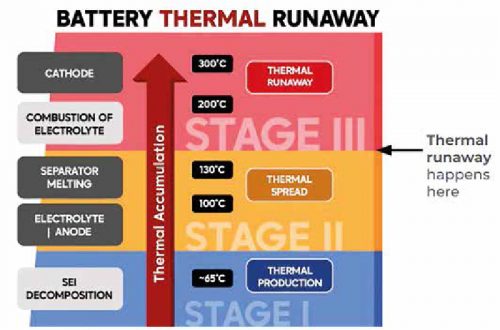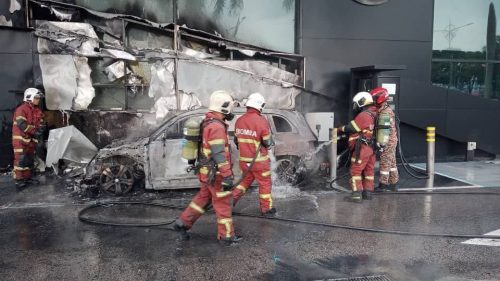As electric vehicle (EV) adoption surges in Malaysia, fire safety professionals must confront a pressing issue: Are we prepared for the fire risks posed by this new wave of technology?
While EVs contribute to cleaner air and reduced carbon emissions, their lithium-ion battery systems present unique fire hazards that differ significantly from traditional vehicles. For the fire safety community, these risks must be understood and mitigated as EVs become a central part of Malaysia’s transportation landscape.
The Electric Surge: Malaysia’s Growing EV Market
Malaysia is witnessing a significant shift in its automotive industry, with EV sales rapidly increasing. In the first half of 2024 alone, 10,664 EVs were sold—more than double the 4,410 units sold the previous year. EVs now represent 2.6% of all vehicle sales, reflecting a 148% year-on-year growth. This boom in EV adoption mirrors global trends toward sustainability, but it also brings new challenges for fire safety, especially as EV infrastructure scales up nationwide.
Understanding Lithium-Ion Battery Fires
For those familiar with fire safety, the dangers posed by lithium-ion batteries are well-known but require specialised approaches. Unlike internal combustion engine fires, which typically result from mechanical failures or fuel leaks, EV fires are caused by the chemical instability of lithium-ion cells. The most common and dangerous scenario is thermal runaway.
Thermal runaway occurs when a single battery cell overheats and triggers a chain reaction in adjacent cells. This uncontrolled rise in temperature can cause the battery to ignite and result in a violent, persistent fire. Factors that can lead to thermal runaway include:
• Physical damage from accidents or impacts.
• Overcharging, where excessive voltage causes internal overheating.
• Manufacturing defects, which can lead to short circuits or structural failure.
The volatility of these fires is compounded by their persistence. Once a lithium-ion fire ignites, it can be difficult to extinguish and may reignite even after it seems to be under control. Additionally, these fires release toxic gases, such as hydrogen fluoride, which can be hazardous in confined spaces.

Increasing Fire Risk with EV Adoption
As EV numbers continue to rise, so do fire incidents linked to their lithium-ion batteries. Globally, a high-profile incident occurred in South Korea in August 2023, where a Mercedes-Benz EV fire in an underground parking lot destroyed over 140 vehicles. The event sparked widespread concerns and led to discussions on restricting EV access to underground parking areas due to containment and ventilation challenges.
Malaysia, too, has seen EV fire incidents. In Johor, on December 31, 2023, an electric car caught fire while charging at a showroom along Jalan Skudai. The blaze destroyed 90% of the vehicle, 5% of the showroom structure, and 20% of the EV charging bay, according to the Larkin Fire and Rescue Station. This incident highlights the difficulty in controlling such fires and the significant damage they can cause, especially in enclosed spaces like garages and underground parking lots, which are commonly found in Malaysia’s urban centres.
An electric car catches fire while charging at a showroom in Johor Bahru, destroying 90% of the vehicle. Source: The Star, December 31, 2023. Click here to read the full news.

Malaysia’s Expanding EV Infrastructure
The growing EV infrastructure in Malaysia adds complexity to the fire risk landscape. As of June 25, 2024, the country has installed 2,585 EV charging units, spanning all states and federal territories except Labuan. These include 610 direct current (DC) fast chargers and 1,975 alternating current (AC) chargers. Selangor leads with 867 chargers, followed by Kuala Lumpur (675), Penang (277), and Johor (251). With the number of EV charging points steadily increasing—up 12.5% since the first quarter of 2024— fire safety at these stations becomes a critical issue. The Ministry of Investment, Trade and Industry (MITI) has projected that Malaysia will reach 10,000 public EV charging points by 2025, a key part of the Low Carbon Mobility Blueprint 2021-2030. However, as the EV fleet grows, ensuring these charging points are equipped to handle potential fire hazards is essential.
Implications for Structural Safety
Beyond the immediate threat to life, EV fires pose serious risks to infrastructure. Lithium-ion battery fires burn at higher temperatures than conventional vehicle fires, potentially compromising the structural integrity of surrounding materials, including steel and concrete. Other structural risks include:
• Heat Intensity: The extreme heat from these fires can weaken load-bearing elements in buildings, particularly in enclosed spaces like underground parking lots.
• Toxic Smoke: Fires involving lithium-ion batteries release hazardous gases, such as hydrogen fluoride, which can quickly fill confined areas and pose health risks to both building occupants and first responders.
• Re-Ignition Potential: One of the most dangerous aspects of lithium-ion battery fires
is their tendency to reignite even after they appear to have been extinguished. This makes them particularly hazardous in enclosed or difficult-to-access spaces, where containment is challenging.
In dense urban areas or facilities with limited ventilation, such as underground garages, these risks are amplified. Poor ventilation and inadequate fire suppression systems can lead to catastrophic outcomes.
Addressing the Challenges: Mitigation and Prevention Strategies
For fire safety professionals, adapting current protocols to address the specific hazards of EV fires is critical. Existing systems designed for traditional vehicle fires may not be sufficient to combat the unique risks of lithium-ion batteries. Key mitigation strategies include:
1. Enhanced Fire Suppression Systems:
Fire detection and suppression systems in high- risk areas, such as underground parking lots, must be upgraded. Specialised equipment, such as water mist systems are required to effectively penetrate battery casings and cool the cells, preventing thermal runaway from escalating.
2. EV Fire Blankets:
EV fire blankets, designed to smother and contain fires caused by lithium-ion battery cells, offer a critical solution for managing the unique fire hazards posed by electric vehicles. These blankets can prevent fires from spreading to adjacent vehicles or infrastructure, particularly in high-risk environments like charging stations and underground parking garages.
Malaysia has taken commendable steps in this regard by including the deployment of vehicle fire blankets as part of BOMBA’s fire safety regulations for electric vehicle charging bays. Given the challenges of controlling an EV fire once it escalates, these blankets play a crucial role in mitigating potential damage to both the vehicles and surrounding infrastructure. This regulation is a progressive move, reflecting the importance of adapting fire safety protocols as EV adoption continues to grow across the country.

3. Safe Charging Practises:
Ensuring that EV charging infrastructure adheres to strict safety standards is critical. Certified EV chargers should be used, and installation quality should be prioritised to avoid issues such as overcharging, which could lead to overheating and fires.
4. Building Design and Ventilation
Future developments, especially in urban areas, must account for the unique risks posed by EVs. This includes equipping buildings with proper ventilation systems to disperse toxic gases and installing advanced fire detection systems capable of identifying fires before they spread.
5. Public and Professional Training
Firefighters, building managers, and EV owners need to be educated on the specific dangers of lithium-ion battery fires. Training for first responders should emphasize the difference between conventional vehicle fires and EV-related incidents to ensure the appropriate actions are taken.
Conclusion: Preparing for the Inevitable
The rise of EVs in Malaysia is an important step toward sustainability, but it also presents new fire safety challenges. As more EVs hit the roads and charging infrastructure expands, fire safety professionals must stay ahead of these developments. Adopting advanced suppression systems, improving building designs, and promoting safe charging practices are essential steps to ensure that the benefits of EV adoption do not come at the cost of safety.
Malaysia’s evolving infrastructure must be equipped to handle the growing presence of EVs. With proactive measures in place, the fire safety community can help mitigate the risks and ensure a safer future as we transition to cleaner, greener transportation solutions.
To better prepare for these challenges, fire safety professionals must also receive specialized training. Our fire safety training services are designed to help first responders, building managers, and safety personnel understand the nuances of lithium-ion battery fires and EV-specific risks. Our courses provide the critical skills needed to manage these high-risk incidents effectively.
What Civilians Can Do During an EV Fire
While specialized training is essential for professionals, civilians must also be aware of the risks and basic steps they can take if an EV fire occurs:
1. Evacuate the Area: Lithium-ion battery fires can release toxic gases and quickly become dangerous. Move away from the vehicle and alert others to evacuate.
2. Call Emergency Services: Immediately contact emergency responders. Let them know it’s an EV fire, as this requires specialized handling.
3. Do Not Attempt to Extinguish the Fire Yourself: EV fires are complex and often require specialized equipment. Never try to use water or a conventional fire extinguisher unless explicitly trained to do so.
4. Keep a Safe Distance: Lithium-ion fires can reignite and explode. Stay far away, even if the fire appears to have subsided.
References:
• EV sales in Malaysia for the first half of 2024 more than double from last year, up 148% year-on- year. (n.d.). EV Connection. Retrieved from https://www.ev-connection.com
• Choi, J. (2024, August 16). Electric vehicle fire destroys 140 vehicles in underground parking lot. The Korea Herald. Retrieved from https://www.koreaherald.com
• Electric car catches fire while charging at showroom in JB. (2023, December 31). The Star. Retrieved from https://www.thestar.com.my
• 2,585 EV charging units installed as of June 25, 2024 – MITI. (n.d.). MIDA. Retrieved from https://www.mida.gov.my
